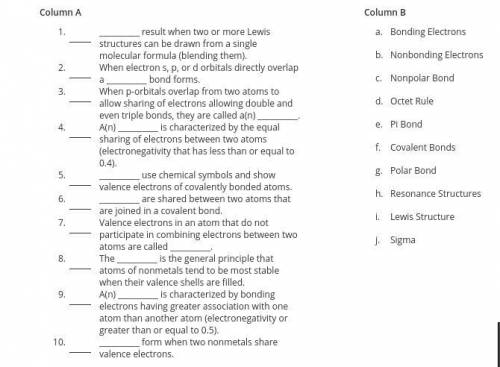PLEASE HURRY
1.
_ result when two or more Lewis structures can be drawn from a single molecul...

PLEASE HURRY
1.
_ result when two or more Lewis structures can be drawn from a single molecular formula (blending them).:
_ result when two or more Lewis structures can be drawn from a single molecular formula (blending them).
2.
When electron s, p, or d orbitals directly overlap a _ bond forms.:
When electron s, p, or d orbitals directly overlap a _ bond forms.
3.
When p-orbitals overlap from two atoms to allow sharing of electrons allowing double and even triple bonds, they are called a(n) _.:
When p-orbitals overlap from two atoms to allow sharing of electrons allowing double and even triple bonds, they are called a(n) _.
4.
A(n) _ is characterized by the equal sharing of electrons between two atoms (electronegativity that has less than or equal to 0.4).:
A(n) _ is characterized by the equal sharing of electrons between two atoms (electronegativity that has less than or equal to 0.4).
5.
_ use chemical symbols and show valence electrons of covalently bonded atoms.:
_ use chemical symbols and show valence electrons of covalently bonded atoms.
6.
_ are shared between two atoms that are joined in a covalent bond.:
_ are shared between two atoms that are joined in a covalent bond.
7.
Valence electrons in an atom that do not participate in combining electrons between two atoms are called _.:
Valence electrons in an atom that do not participate in combining electrons between two atoms are called _.
8.
The _ is the general principle that atoms of nonmetals tend to be most stable when their valence shells are filled.:
The _ is the general principle that atoms of nonmetals tend to be most stable when their valence shells are filled.
9.
A(n) _ is characterized by bonding electrons having greater association with one atom than another atom (electronegativity or greater than or equal to 0.5).:
A(n) _ is characterized by bonding electrons having greater association with one atom than another atom (electronegativity or greater than or equal to 0.5).
10.
_ form when two nonmetals share valence electrons.:
_ form when two nonmetals share valence electrons.
Column B
a. Bonding Electrons
b. Nonbonding Electrons
c. Nonpolar Bond
d. Octet Rule
e. Pi Bond
f. Covalent Bonds
g. Polar Bond
h. Resonance Structures
i. Lewis Structure
j. Sigma


Answers: 1


Another question on Chemistry

Chemistry, 22.06.2019 11:00
Freezing and boiling are endothermic processes. this means that these processes absorb energy from their surroundings in order to occur. use this information and the data you collected in the phase change gizmo to describe what happens to the temperature of water when you boil it, then explain why this result occurs.
Answers: 1

Chemistry, 22.06.2019 14:00
8.98 dm3 of hydrogen gas is collected at 38.8 °c. find the volume the gas will occupy at -39.9 °c if the pressure remains constant.
Answers: 3

Chemistry, 23.06.2019 07:00
Choose the correct statement about licensed veterinarians in the united states. a. they must be certified by the avma. b. they can treat all nonhuman animals. c. they can can treat only animals specified on the license. d. they must choose a specialty.
Answers: 2

Chemistry, 23.06.2019 08:50
Why are enzymes important to cells? they bring about chemical reactions. they provide structural support. they form the two layers of membranes. they store large quantities of energy.
Answers: 2
You know the right answer?
Questions

History, 03.11.2020 06:40

Biology, 03.11.2020 06:40

History, 03.11.2020 06:40



History, 03.11.2020 06:40


History, 03.11.2020 06:40

Mathematics, 03.11.2020 06:40

Mathematics, 03.11.2020 06:40



Social Studies, 03.11.2020 06:40



Chemistry, 03.11.2020 06:40

Advanced Placement (AP), 03.11.2020 06:40


English, 03.11.2020 06:40




